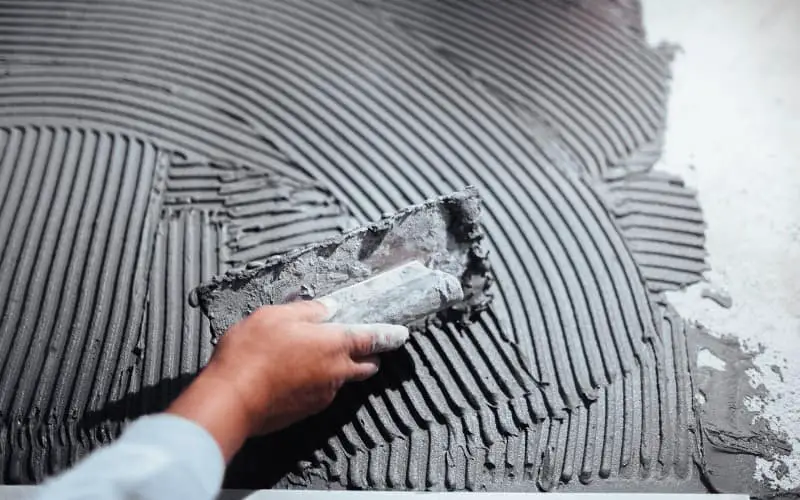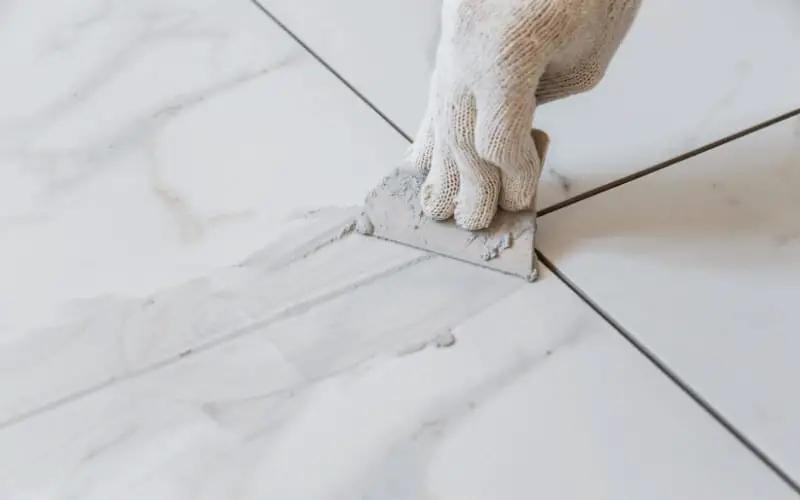There are a number of difference between sanded and unsanded grout, and The choice is determined mostly by the width of the joint between tiles.
If you are planning to embark on a tile installation project, after choosing the type of color of tiles you want, you will find out that there is a myriad of choices beyond that in the form of grout.
Tile grout acts like a binding agent to keep the tiles together, and there are only two types of cement-based grout, which are sanded and unsanded.
Difference Between Sanded And Unsanded Grout
Table of Contents
There are different differences between unsanded and sanded grout; if you are a DIYer, you probably don’t already know that, and you may feel they are both the same; however, they are not.
So let’s talk about the differences so you can be able to compare between both grout options and make the right choice for your project. But before we jump right into that, what is tile grout?
What Is Tile Grout
There are actually three different types of grout, but today we are talking about cement grout, also known as tile grout. Cement grouts, as the name implies, have cement as their main component; they also have filler particles of different sizes, a water-retentive additive, and colored pigments.
Cement grouts are the traditional grouting material, used most often in residential applications as well as some commercial applications. They are available in a range of colors that allows you to match or contrast with the tile you are applying it to.
This grout is mixed with water and applied with a trowel. The water retentive agent in cement grouts increases the drying time, allowing the cement to slowly cure for maximum hardness. As stated earlier, there are two types of cement or tile grout; sanded and unsanded.
Read: Does steam mop damage tile floor?
Sanded Grout
Sanded grout contains fine particles of silica sand, which are added to reinforce the structure and durability of the grout. Sanded grout looks coarser and has a rough texture; it is basically a mixture of powdered pigments, water, cement, and sand make this sanded grout.
It’s a go-to choice for most tiling work since sand particles have the ability to lock with each other to form a sturdy joint.
Sanded grout is widely available and has the widest range of color, and it experiences less grout shrinkage. Sanded grout is a great option for interior flooring, all thanks to Its durability and stability that allows it to stand up to the pressure of foot traffic.
If you are someone who’s really into the idea of matching your grout color with the tile color, then a sanded grout might just be the best choice as they are available in different color choices.
Also, if you have tile joints that are 1/8-inch to ½-inch wide, then a sanded grout is the best applicable as The sand particles will help to keep the tiles together without any breakage or shrinkage. Also, applying sanded grout to large joints is very easy. It also helps in slip-resistance on wet floors.
If you are doing your project on a tight budget, then sanded might just help you achieve your desired results without having to break the bank.
Sanded grout is so inexpensive is because sand is quite literally dirt-cheap, and it forms the bulk of sanded tile grout, but they can only be applied on surfaces where the possibility of scratching from the sand content in the tile grout will not be a problem. Sanded grout is a grout option to use on kitchen floors, bathroom, or shower area.
Read: Can you use wall tile on the floor?
However, after applying a sanded grout and it has fully cured, you will need to apply a layer of sealant to avoid cracking, this is due to the porous nature of sand, which is the main component, and without proper sealing, there will be water infiltration from the back of the tile which can ruin the substrate it is also recommended to re-seal it once or twice a year.
Unsanded Grout
Unsanded grout, on the other hand, contains no sand and is best used for delicate surfaces like glass tiles and for thin grout lines. It takes only a simple mixture of powdered pigments, cement, and water to make this type of grout.
Due to the absence of sand in the grout, it has a very smooth texture, so, therefore, it will not scratch your tile surface. Unsanded grout is not recommended for first-timers or DIYers, as it requires more expertise in the application.
Read: does Steam cleaning damage grout
Unsanded grout is also called non-sanded grout, and it is the best option for very thin grout lines ranging from 1/8-inch down to 1/16-inch.
While Unsanded grout is easier to work with compared to sanded grout on vertical surfaces such as tiled shower walls, this is because Vertical tiles are usually closer together, and they usually have a width measuring less than 1/8 of an inch.
Due to the less space between the tiles, a filler isn’t required to keep the grout and the tiles in place. Also, The lack of silica aggregate filler in unsanded grout means that it works well with scratchable surfaces such as some ceramic, glass, natural stone tile, marble, or metal.
One of the benefits of using unsanded grout is that you don’t have to seal it afterward. Because there is no sand, it is less porous, and therefore doesn’t need an extra layer to protect it.
However, unsanded grout is not hard enough to withstand heavy foot traffic. So it is not recommended for it to be used in areas with high foot traffic as it can shrink easily. For larger tile gaps above 1/8-inch, it is not strong enough to hold the tiles together for a long time.
Unsanded grout is also almost twice as expensive as sanded grout because of the pricey polymers often used as binders. While sanded grout can be used as the default grout choice for everything except for a few areas that absolutely require unsanded grout.
Using unsanded grout as your universal grout for all applications can be detrimental because it does not hold up structurally well as sanded grout. Unsanded grout comes in different colors but not as many as sanded grout.
Conclusion
There is no clear winner between the two types of tile grout; the difference between sanded and unsanded grout makes them unique in their own way. Getting the best out of any of these two options all depends on the tiling job itself and even the application. Even your budget plays a role here.



